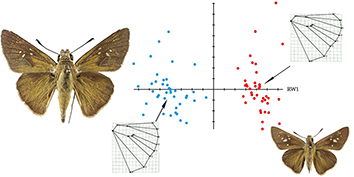Volume 7, Issue 4 (2021)
J. Insect Biodivers. Syst 2021, 7(4): 391-407 |
Back to browse issues page
Download citation:
BibTeX | RIS | EndNote | Medlars | ProCite | Reference Manager | RefWorks
Send citation to:



BibTeX | RIS | EndNote | Medlars | ProCite | Reference Manager | RefWorks
Send citation to:
Zerganipour A, Esfandiari M, Rabieh M M. Geometric morphometric study of sexual dimorphism and its associated allometry in wings of Pelopidas thrax (Lep.: Hesperiidae). J. Insect Biodivers. Syst 2021; 7 (4) :391-407
URL: http://jibs.modares.ac.ir/article-36-53039-en.html
URL: http://jibs.modares.ac.ir/article-36-53039-en.html
1- Department of Plant Protection, Faculty of Agriculture, Shahid Chamran University of Ahvaz, Ahvaz, Iran.
2- Department of Plant Protection, Faculty of Agriculture, Shahid Chamran University of Ahvaz, Ahvaz, Iran. ,apameini@yahoo.com
3- Department of Plant Protection, Faculty of Agriculture, University of Birjand, Birjand, Iran.
2- Department of Plant Protection, Faculty of Agriculture, Shahid Chamran University of Ahvaz, Ahvaz, Iran. ,
3- Department of Plant Protection, Faculty of Agriculture, University of Birjand, Birjand, Iran.
Abstract: (1894 Views)
Pelopidas thrax (Hübner) (Lep.: Hesperiidae) is a widespread species in southwest Iran. We aimed to use geometric morphometric techniques to investigate the sexual dimorphism and allometric effects associated with the wings of P. thrax. Fore- and hind wings of 40 and 39 individuals, respectively, of each sex which were collected from Ahvaz city were digitized and analyzed. Sexual dimorphism was observed in size and shape of fore- and hind wings of P. thrax and was graphically illustrated. Multivariate statistics confirmed significant differences in shape of fore- and hind wing between sexes. Centroid size of both wings showed greater values in females than males and visualized by boxplots. Various multivariate regressions of shape coordinates on centroid size were significant and visualized by the thin plate splines. Allometry explained shape variance in each case between 0.8% to 19.6%. The analysis demonstrated different allometric patterns for sexes in both fore- and hind wings. Significant shape differences between wings of males and females were still remained after removing allometric effects. The variation that is not related to size could be attributed to specific behaviors such as flight speed and performance in each sex. However, specific experiments are needed to confirm the association of the wing shape variation expressed in this study with the flight traits.
Article Type: Research Article |
Subject:
Systematics/Lepidoptera
Received: 2021/06/6 | Accepted: 2021/09/28 | Published: 2021/10/11
Received: 2021/06/6 | Accepted: 2021/09/28 | Published: 2021/10/11
References
1. Adams, D.C. & Otarola-Castillo, E. (2013) Geomorph: an r package for the collection and analysis of geometric morphometric shape data. Methods in Ecology and Evolution, 4, 393–399. [https://doi.org/10.1111/2041-210X.12035]
2. Adams, D.C., Rohlf, F.J. & Slice, D.E. (2004) Geometric morphometrics: ten years of progress following the ‘revolution’. Italian Journal of Zoology, 71 (1), 5–16. [https://doi.org/10.1080/11250000409356545]
3. Alavi, S. (2018) Identification of Catocala (Lep.: Erebidae) species in oak forests of Khuzestan and study of sexual dimorphism and allometry in two species of the genus (Unpublished MSc Thesis), Faculty of Agriculture, Shahid Chamran University of Ahvaz.
4. Allen, C.E., Zwaan, B.J. & Brakefield, P.M. (2011) Evolution of sexual dimorphism in the Lepidoptera. Annual Review of Entomology, 56, 445–464. [https://doi.org/10.1146/annurev-ento-120709-144828]
5. Anderson, M.J. (2001) A new method for non-parametric multivariate analysis of variance. Austral Ecology, 26 (1), 32–46. [https://doi.org/10.1111/j.1442-9993.2001.01070.pp.x]
6. Arak, A. (1988) Sexual dimorphism in body size: a model and a test. Evolution, 42 (4), 820–825. [https://doi.org/10.2307/2408874]
7. Benítez, H.A., Parra, L.E. Sepulveda, E. & Sanzana, M.J. (2011) Geometric perspectives of sexual dimorphism in the wing shape of Lepidoptera: the case of Synneuria sp. (Lepidoptera: Geometridae). Journal of Entomological Research Society, 13 (1), 53–60.
8. Benítez, H.A. & Vargas, H.A. (2017) Sexual dimorphism and population differention in the Chilean Neotropical moth Macaria mirthae (Lepidoptera: Geometridae): a wing geometric morphometric example. Revista Brasileira de Entomologia, 61 (4), 365–369. [https://doi.org/10.1016/j.rbe.2017.06.003]
9. Benson, W.W., Haddad, C.F.B., & Zikan, M. (1989) Territorial behavior and dominance in some heliconiidae butterflies (Nymphalidae). Journal of the Lepidopterists Society, 43 (1), 33–49.
10. Betts, C.R. & Wootton, R.J. (1988) Wing shape and flight behaviour in butterflies (Lepidoptera: Papilionoidea and Hesperioidae): a preliminary analysis. Journal of Experimental Biology 138, 271–288. [https://doi.org/10.1242/jeb.138.1.271]
11. Beukeboom, L.W. (2018) Size matters in insects – an introduction. Entomologia Experimentalis et Applicata, 166 (1), 2–3. [https://doi.org/10.1111/eea.12646]
12. Bookstein, F.L. (1991) Morphometric tools for landmark data: geometry and biology. Cambridge University Press, Cambridge. 435 pp.
13. Camargo, W.R.F., Camargo, N.F., Correa, D.C.V, Camargo, A.J.A., & Dinizi, I.R. (2015) Sexual dimorphism and allometric effects associated with the wing shape of seven moth species of Sphingidae (Lepidoptera: Bombycoidea). Journal of Insect Science, 15 (1), 107. [https://doi.org/10.1093/jisesa/iev083]
14. Cock, M. J.W. (2009) Observations on the biology of Pelopidas thrax (Hübner) (Lepidoptera: Hesperiidae: Hesperiinae) in the Hajar Mountains, Oman. Tribulus, 18, 42–49.
15. DeVries, P.J., Penz, C. M., & Hill, R.I. (2010) Vertical distribution, flight behavior and evolution of wing morphology in Morpho butterflies. Journal of Animal Ecology, 79 (5), 1077–1085. [https://doi.org/10.1111/j.1365-2656.2010.01710.x]
16. Dudley, R. (2000) The biomechanics of insect flight: from, function, evolution. Princeton University Press, Princeton, NJ. 496 pp.
17. Fairbairn, D.J. (1997) Allometry for sexual size dimorphism: pattern and process in the coevolution of body size in males and females. Annual Review of Ecology and Systematics, 28, 659–687. [https://doi.org/10.1146/annurev.ecolsys.28.1.659]
18. Goodal, C. (1991) Procrustes methods in the statistical analysis of shape. Journal of the Royal statistical Society, Series B (Methodological), 53 (2), 285–321. [https://doi.org/10.1111/j.2517-6161.1991.tb01825.x]
19. Hernández, L. N., Barragán A.R., Dupas S., Silvain J.F. & Dangles O. (2010) Wing shape variations in an invasive moth are related to sexual dimorphism and altitude. Bulletin of Entomological Research, 100 (5), 529–541. [https://doi.org/10.1017/S000748530999054X]
20. Hoffmann, A.A., Woods, R.E., Collins, E., Wallin, K., White, A. & McKenzie, J.A. (2005) Wing shape versus asymmetry as an indicator of changing environmental conditions in insects. Australian Journal of Entomology, 44, 233–243. [https://doi.org/10.1111/j.1440-6055.2005.00469.x]
21. IBM Corp. (2016) IBM SPSS Statistics for Windows, Version 24.0. Armonk, NY: IBM Corp.
22. Iglesias, M.S., Crespo, F.A. & Valverde, A.C. (2012) Is parental care behavior in Belostoma species an evolutionary cause for their common sexual size dimorphism pattern? Entomological Science, 15 (2), 155–161. [https://doi.org/10.1111/j.1479-8298.2011.00499.x]
23. Jeratthitikul, E., Yago, M. & Hikid, T. (2014) Sexual dimorphism and intraspecific variation in wing size and shape of Tongeia fischeri (Lepidoptera: Lycaenidae). Entomological Science, 17 (3), 342–353. [https://doi.org/10.1111/ens.12068]
24. Khaghaninia, S., Mohammadi, S.A., Sarafrazi, A., Hadade Iraninejad, K., Ebrahimi, A., Alavikia, S. & Zahiri, R. (2008) Geometric morphometric approach on the sexual dimorphism of Cydia pomonella (Lep.: Tortricidae) in the north west of Iran. Journal of Entomological Society of Iran, 28 (1), 51–62.
25. Kikukawa, N. & Hikida, T. (2012) Geometric morphometric analysis of sexual dimorphism and allometric growth in the skull of the Japanese Grass Lizard, Takydromus tachydromoides (Reptilia: Lacertidae). Current Herpetology, 31 (2), 97–106. [https://doi.org/10.5358/hsj.31.97]
26. Laguerre, M. (2016) Sex pairing of three highly dimorphic Arctiinae (Lepidoptera: Erebiidae) females in French Guyana and description of three new species from Brazil. Journal of Insect Biodiversity, 4 (21), 1–26. [https://doi.org/10.12976/jib/2016.4.21]
27. Lockwood, R., Sawaddle, J.P. & Rayner, J.M.V. (1998) Avian wingtip shape reconsidered: wingtip shape indices and morphological adaptations to migration. Journal of Avian Biology, 29, 273–292. [https://doi.org/10.2307/3677110]
28. Moraes, S.S., Cardoso, L.W., Silva-BrandoÃo, K.L. & Duarte, M. (2017) Extreme sexual dimorphism and polymorphism in two species of the tiger moth genus Dysschema (Lepidoptera: Erebidae): association between males and females, sexual mimicry and melanism revealed by integrative taxonomy. Systematics and Biodiversity, 15 (3), 259–273. [https://doi.org/10.1080/14772000.2016.1250835]
29. Moreno, A. & Viloria A. (2020) Variation in hindwing size and shape of Plutella xylostella (Linnaeus, 1758) (Lepidoptera: Plutellidae). SHILAP Revista de lepidopterología, 48 (192), 709–714.
30. Mozaffarian, F., Sarafrazi, A. & Nouri Ganbalani, G. (2007) Sexual dimorphism in the wing shape and size of the carob moth Ectomyelois ceratoniae (Lepidoptera: Pyralidae). Journal of Entomological Society of Iran, 26 (2), 61–73.
31. Przybylowicz, L. & Tarcz, S. (2015) Strong sexual dimorphism unraveled by DNA analysis—towards a better understanding of Pseudothyretes classification (Lepidoptera: Erebidae: Arctiinae). Zoological Journal of the Linnean Society, 173 (1), 22–54. [https://doi.org/10.1111/zoj.12198]
32. Rohlf, F.J. (2015) The Tps series of software. Hystrix, 26 (1), 1–4. [https://doi.org/10.4404/hystrix-26.1-11264]
33. Rholf, F.J. (2016) tpsRegr, Version 1.45. Stonyn Brook, NY: Department of Ecology and Evolution. State University of New York.
34. Rohlf, F.J. & Slice, D.E. (1990) Extensions of the Procrustes method for the optimal superimposition of landmarks. Systematic Zoology, 39 (1), 40–59. [https://doi.org/10.2307/2992207]
35. Scoble, M.J. (1992) The Lepidoptera: form, function and diversity. Oxford University Press, New York, U.S.A. 400 pp.
36. Sherratt, E. (2016) Quick guide to geomorph. Available from: http://www.emmasherratt.com/ uploads/2/1/6/0/21606686/quick_guide_to_geomorph_introduction.html [Accessed 5th June 2021]. [http://www.emmasherratt.com/]
37. Shi, J., Chen, F. & Keena, M.A. (2015) Differences in wing morphometrics of Limantria dispar (Lepidoptera: Erebidae) between population that vary in female flight capability. Annals of the Entomological Society of America, 108 (4), 528–535. [https://doi.org/10.1093/aesa/sav045]
38. Stillwell, R.C., Blanckenhorn, W.U., Teder, T., Davidowitz, G. & Fox, C.W. (2010) Sex differences in phenotypic plasticity affect variation in sexual size dimorphism in insects: from physiology to evolution. Annual Review of Entomology, 55, 227–245. [https://doi.org/10.1146/annurev-ento-112408-085500]
39. Strauss, R.E. (1990) Patterns of quantitative variation in lepidopteran wing morphology: the convergent groups heliconiinae and ithomiinae (Papilionoidea: Nymphalidae). Evolution, 44 (1), 86–103. [https://doi.org/10.1111/j.1558-5646.1990.tb04281.x]
40. Tamagnini, D., Stephenson, J., Brown, R.B. & Meloro, C. (2018) Geometric morphometric analysis of sexual dimorphism and allometry in two sympatric snakes: Natrix helvetica (Natricidae) and Vipera berus (Viperidae). Zoology, (129), 25–34. [https://doi.org/10.1016/j.zool.2018.05.008]
41. Tobler, A., & Nijhout, H.F. (2010) Developmental constraints on the evolution of wing-body allometry in Manduca sexta. Evolution & Development, 12 (6), 592–600. [https://doi.org/10.1111/j.1525-142x.2010.00444.x]
42. Vargas, R.E.M., Ya-Umphan, P., Phumala-Morales, N., Komalamisra, N. & Dujardin, J.P. (2010) Climate associated size and shape changes in Aedes aegypti (Diptera: Culicidae) populations from Thailand. Infection, Genetics and Evolution, 10, 580–585. https://doi.org/10.1016/j.meegid.2010.01.004
43. Wiklund, C. (2003) Sexual selection and evolution of butterfly mating systems. In: Boggs, C.L. & Watt, W.B. and Ehrlich, P.R. (eds.) Butterflies: ecology and evolution taking flight. University Chicago Press, Chicago, IL. pp. 67–90.
44. Xue, G.X., Li Y.F., Liu, Z.H., Li, M. & Ren, Y.D. (2016) Distribution of Onryza maga (Leech, 1890) (Lepidoptera: Hesperiidae) with description of female genitalia and taxonomic notes. Entomologica Fennica, 27, 70–76. [https://doi.org/10.33338/ef.59125]
45. Zahiri, R., Sarafrazi, A. Salehi, L. & Kunkel, J.G. (2006) A geometric morphometric study on populations of the rice stem borer, Chilo suppressalis Walker (Lepidoptera: Crambidae) in northern Iran. Zoology in the Middle East, 38 (1), 73–84. [https://doi.org/10.1080/09397140.2006.10638168]
46. Zelditch, M.L., Swiderski, D.L., Sheets, H.D. & Fink, W.L. (2004) Geometric morphometrics for biologists: a primer. Elsevier, New York. 437 pp.
47. Zerganipour, A., Esfandiari, M., Naderi, A., Rabieh, M.M. (2019) Identification of the butterflies (Lepidoptera, Papilionoidea) in the IMCA (Insect and Mite Collection of Ahvaz) at Shahid Chamran University of Ahvaz, Khuzestan, Iran. Phegea, 47 (4), 129–139.
48. Zhai, Q., Xue, G-x. & Li, M. (2017) DNA barcoding-based sexual association of Sovia lucasii and S. lii (Lepidoptera: Hesperiidae), with description of a new subspecies. PLoS ONE 12(8): e0183847. [https://doi.org/10.1371/journal.pone.0183847]
Send email to the article author
| Rights and permissions | |
 |
This work is licensed under a Creative Commons Attribution-NonCommercial 4.0 International License. |










